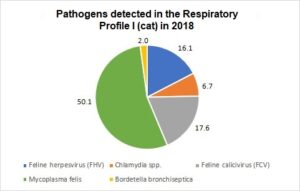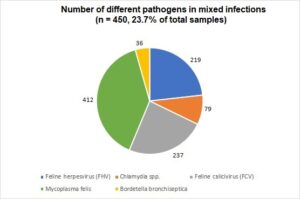Infections with the various causative agents of feline upper respiratory disease complex occur regularly despite available vaccines. Particularly with high population densities and the resulting high infection pressure, as is often the case in boarding or breeding catteries and animal shelters, the occurrence of diseases can be a serious problem. The five primary causative agents of feline upper respiratory disease are feline herpesvirus 1 (FHV1), feline calicivirus (FCV), Chlamydia (C.) felis, Bordetella (B.) bronchiseptica and Mycoplasma (M.) felis. The symptoms are manifold and can therefore often not be clearly assigned to one pathogen or the other. They can range from mild, watery nasal discharge to severe, fatal systemic disease. Rhinitis, conjunctivitis, lesions of the oral cavity and the cornea, fever and pneumonia are observed. In addition to the primary causative agents mentioned above, there are often non-specific secondary bacterial pathogens. Mixed infections with two or more different pathogens of the feline upper respiratory disease complex are common.
Feline calicivirus is highly contagious, and due to its high variability and mutation rate, there are multiple virus variants with greatly varying virulence, some of which cause severe systemic disease with a high fatality rate. Symptoms depend on the virulence of the virus variant as well as on the immune status of the particular cat. Possible signs include ulcers in the oral cavity, problems with the upper respiratory tract, high fever and occasional lameness caused by transient arthritis. The virus is shed in oronasal and conjunctival secretions for up to four weeks and is transmitted both directly and indirectly. It is environmentally stable for a long time and remains infectious on dry surfaces for up to one month. Even after overcoming the disease, many cats continue to shed the virus, sometimes for several years. Virus detection by PCR is very sensitive, so that in individual cases, vaccine viruses are also detected which may be shed in very small quantities for a few weeks after vaccination. On the other hand, the high mutation rate of the virus can also lead to false negative results.
Following an infection with feline herpesvirus 1, the animals remain latent carriers of the virus for life. Stress or immunosuppression can lead to a reactivation of the disease. Symptoms consist of acute rhinitis and conjunctivitis with fever, blepharospasm and anorexia; especially in young cats, particularly severe pneumonia with fatal outcome may sometimes occur. Herpesviruses have been described as being associated with ulcerative dendritic keratitis and are considered the main cause of this disease. Symptoms normally subside after two weeks. The virus is usually only shed for a short period of time, in some cases up to three weeks, in oral, nasal and conjunctival secretions. PCR detection has a very high sensitivity and even very low-level shedders are reliably detected.
- Fig. 1: Pathogens detected (%) in the Respiratory Profile I (cat) in 2018
- Fig. 2: Number of different pathogens in mixed infections
- Tab. 1: Number of mixed infections in the Respiratory Profile I (cat) in 2018 (total number of samples n = 1897)
- Tab. 2: Mixed infections and frequency of occurrence of the individual pathogens of feline upper respiratory disease (FCV, FHV, chlamydia, mycoplasma, B. bronchiseptica) in 2018
Chlamydia felis is an obligate intracellular bacterium and a common cause of acute and chronic conjunctivitis. Symptoms on the eye also include hyperaemia of the nictitating membrane and ocular discharge. However, keratitis and ulcerations are rather uncommon. If they occur, it indicates the involvement of feline herpesvirus. In some cases, infection with FHV1 is accompanied by fever, inappetence, weight loss and respiratory symptoms, and in pregnant animals, abortion may occur. According to the literature, young cats under 9 months of age are most frequently affected, which is confirmed by our data. Transmission occurs through close contact, as the bacterium cannot survive outside the host. Shedding of the pathogen can last up to 60 days, occasionally, an even longer, persistent infection is possible. In individual cases, C. felis can be transmitted to humans and cause conjunctivitis. PCR is the most sensitive method for detecting C. felis.
Mycoplasmas are considered part of the normal microflora of the upper respiratory tract. Nevertheless, Mycoplasma felis plays an important role as a pathogen in feline conjunctivitis. Mycoplasmas are less frequently involved in lower respiratory tract infections, although they can also cause severe pneumonia in individual cases. Only very rarely, M. felis shows zoonotic potential in immunocompromised people. It is difficult to culture mycoplasmas; that is why here, too, detection by PCR is the method of choice.
Contrary to dogs (kennel cough complex), Bordetella bronchiseptica only plays a minor role in cats. The bacterium is a primary pathogen that colonises the ciliated epithelium of the host. It is rarely found in the lower respiratory tract of cats, if so, mainly younger animals are affected. Still, every coughing cat should also be tested for B. bronchiseptica. Bordetella can be transmitted from dog to cat and a zoonotic potential cannot be excluded. In addition to swabs of the nasal mucosa and the oropharynx, bronchoalveolar lavage can also be examined. Bacterial culture as well as PCR are suitable methods. However, performing an antibiogram is only possible after culture. If the pathogen is detected in the lavage sample, it is seen as proof of infection.
Diagnosis
In general, PCR is considered the standard method for the detection of the causative agents of feline upper respiratory disease complex. Conjunctival, oral and/or pharyngeal swabs are suitable sample materials for the detection of viral infections, mycoplasma and chlamydia. Ocular swabs should always be taken BEFORE fluorescein or rose bengal are applied. As chlamydia replication is obligate intracellular, they cannot be detected by routine bacteriological methods. Infections with Bordetella bronchiseptica are rather rarely found in cats; a fast and sensitive PCR detection is possible here as well. Since there are often bacterial co-infections, especially in cases involving the eyes, but also in chronic respiratory tract infections, an additional swab with transport medium should be sent in for bacteriological examination including the creation of an antibiogram, in order to be able to initiate a suitable local and/or systemic therapy. For the diagnosis of feline upper respiratory disease, antibody detection is less useful, because many cats are vaccinated or have had pathogen contact as kittens.
Since most infections are often acute as well, it is usually the pathogens which can be detected at the onset of the disease, but not the antibodies that are produced in the further course of the disease. In the literature, it is stated that 80% of upper respiratory tract infections in cats are, above all, caused by FHV1 and FCV. Laboklin offers various PCR profiles for the detection of the most common pathogens of feline upper respiratory disease. Over the past years, in the Respiratory Profile I (FCV, FHV1, chlamydia, mycoplasma, B. bronchiseptica), mycoplasma was found to be the most prevalent pathogen (in up to 50% of the Respiratory Profiles that were examined), followed by calicivirus and herpesvirus (each in about 20% of cats examined). Infections with chlamydia (7 – 9%) and Bordetella (2 – 3%) play a minor role. In the vast majority of cases, Bordetella was found in mixed infections (94.7%), there were only 2 cases (5.3%) in which it was found as single infection.
In total, there were hardly any differences in the occurrence of individual pathogens in each of the years of the evaluated period between 2011 and 1018.
In 2018, 951 (50.1%) of the 1897 total samples for the Respiratory Profile 1 (cat) were positive for mycoplasma, 305 (16.1%) for FHV1, 333 (17.6%) for FCV, 128 (6.7%) for chlamydia and 38 (2%) for B. bronchiseptica (Fig. 1). Of these 1897 total samples, 450 (23.7%) showed mixed infections with two or more causative agents of feline upper respiratory disease (Table 1). Mixed infections of mycoplasma and FCV/FHV1 were most common, followed by infections with mycoplasma and chlamydia and mixed infections with both viruses (Fig. 2).
Table 1: Number of mixed infections in the Respiratory Profile I (cat) in 2018 (total number of samples n = 1897)
Table 2: Mixed infections and frequency of occurrence of the individual pathogens of feline upper respiratory disease (FCV, FHV, chlamydia, mycoplasma, B. bronchiseptica) in 2018







